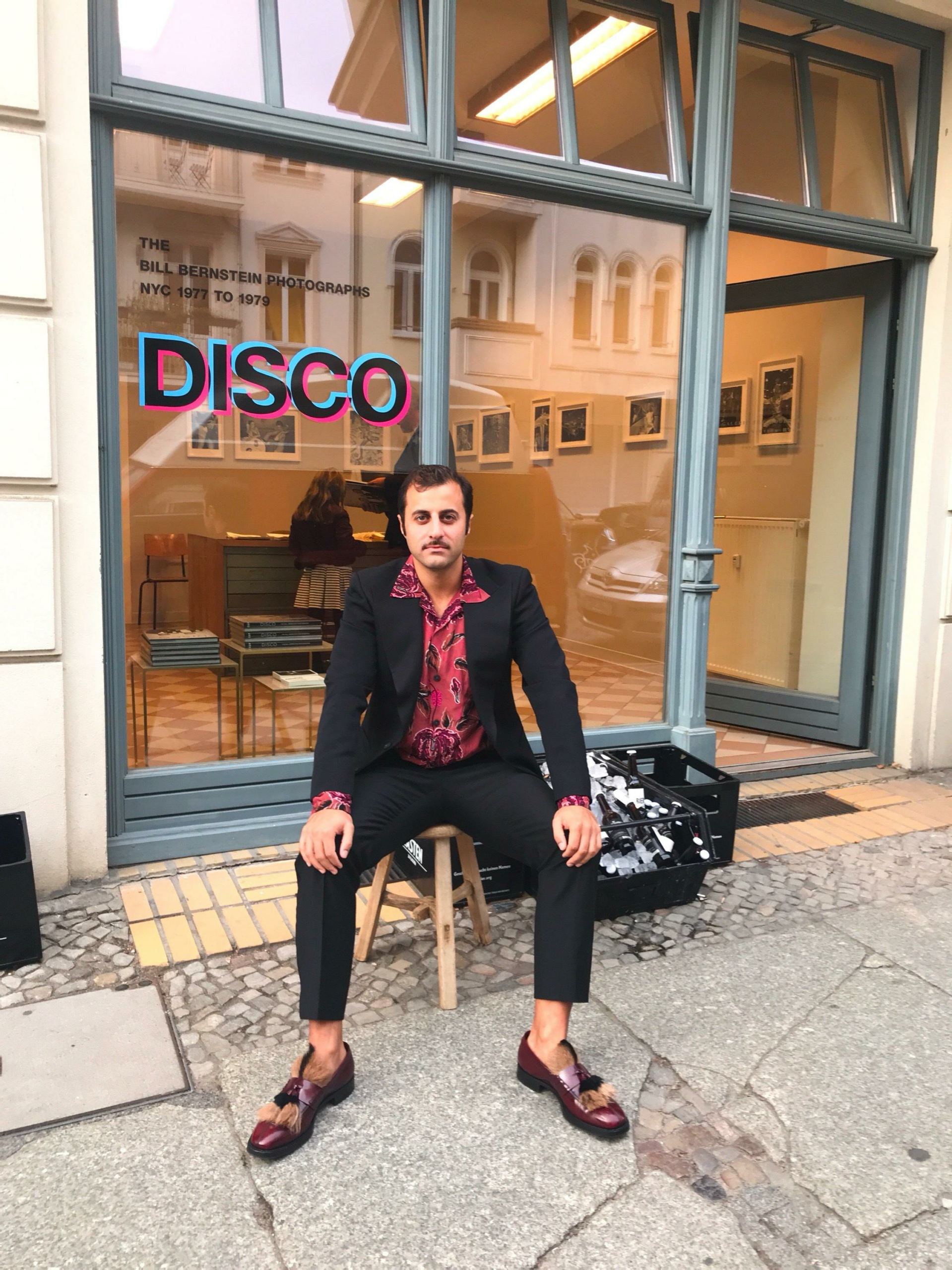Arman Naféei by Bill Bernstein
. So, we’ve asked Arman to do the same throughout this profile.
Arman was born in Cologne, Germany, to Iranian parents who had fled Tehran following the Revolution. His father was a radio journalist who worked for Deustsche Welle (DW), the German equivalent of the BBC, running the Persian department.
At home they spoke Farsi, although Arman would frequently respond in German. “It was a very intellectual, cultural household.’ They maintained their Persian traditions, such as the Nowruz (Spring/New Year) celebration. “My mom would literally be in the kitchen for three days preparing for the big gathering of friends and intellectuals. And then all day, all evening, you would have like 30 strangers in our house, half [of them] playing instruments and reciting [poetry] and half having political discussions and eating and laughing until the wee hours.”
Arman said that at some point his father taught himself to play the Santoor, a Persian instrument akin to a zither or a hammered dulcimer. “I have that sound in my head still – it’s just there.”
Persian Santoor (featuring Vadim Batura)
Arman does not recall experiencing any prejudice or discrimination growing up in Germany where there was a large community of Persians, many of whom were left-wing intellectuals. Although when he declined to attend Catechism, he found himself in the courtyard with other students of Arab parentage and, for the first time, realized he might be “other.”
Parandeh by Googosh
As a child, Arman recalls his mother playing the singer Googosh (Faegheh Atashin), whom he calls the “Persian Beyoncé,” and whose music made a great impression on him. But the performer who he first claimed as his own was Michael Jackson and the song “Smooth Criminal” which Arman performed on stage as a 6 or 7 year old. “So that performing side has always been there,” he said, laughing.
Smooth Criminal by Michael Jackson
Arman’s best friend in Cologne, Max, had two turntables and a mixer in his bedroom. “Of course I wasn’t allowed to touch his records but I was immediately hooked.” As a 14 year old, Arman got a part time job DJing – CDs existed but DJing was still done with vinyl. Arman saved up his money, took a part-time job and bought Vintage Vinyl on eBay, as well as Two Technics turntables and a two-channel mixer. “I started buying records and just practiced, practiced, practiced at home to my poor mother and my neighbors.”
This was the time of illegal downloading services such as Kazaa and Lime. “I would make mix tapes, compilations for love interests and friends on the school yard. And I would just hand them out.” Sharing music that he had curated became second nature. Among his friends, Arman became the Music guy.
At 17, Arman moved to London for University because, he now says, “I was ready to leave Cologne… I wanted to go to the big world and at that time London was the cultural taste maker.” But school was only part of his education. Arman would go to every art exhibition, talk his way into fashion shows, and he was out every night in the clubs. Of that time, Arman says, his friends and he were “just networking and running around like crazy and playing music or trying to [bluff] our way into a gig.”
Arman’s expeditions across London’s cultural scene brought him into the orbit of Sir Norman Rosenthal, at the time the curator of the Royal Academy of Art, who hired Arman as his assistant. Arman was just 20.
“What I learned from Norman was the art of curation. I just took that and applied it to music,” Arman said. “I started to do music for galleries and museums, for events and exhibition openings.”
Go to track in that era? “I started working with Jay Joplin at White Cube Gallery who also became a mentor and a friend of mine. And one of the tracks that really stuck with me was by Roxy Music… that was a very specific time in London.”
Both Ends Burning by Roxy Music
After finishing University, Arman had a residency at King Size Bar in Berlin which was an underground club. Arman was dying to move to New York, and he heard that the Boom Boom Room at the Standard Hotel by the High Line had just opened and was looking for a DJ. But Arman had no idea how he would get to New York and get a work visa.
“The Art World has always been a home for me.. a safe place,” Arman said. Around that time, he traveled to the US to attend Art Basel Miami. He was at an event with Jay Joplin when one of Jay’s friends appeared. Joplin said to him: “André, this my friend Arman. He’s a genius with music. You need to hire him.” André was André Balazs, at the time owner of the Standard Hotel, home to the Boom Boom Room. Arman had to pass several auditions with others in the company, which were “nerve wracking.” Nevertheless, “Three months later I was music director.”
“I was a 24 year old kid from London suddenly in the Big Apple with a big position.” Arman laughed at the recollection, “This was the hottest space in the world and I was part of the team that in charge of making that place happen. So it was a lot of pressure in the beginning.”
“The first time, I walked into the Boom Boom Room it’s like walking into this bottle of gold champagne… and you’re on top of the world over New York City. I was like: What is this place? I will never forget that moment.”
Arman describes himself at the time, jokingly, as “young, courageous and hungry for power.” Unafraid to go up to Debby Harry (who he asked out on a date), to look people in the eye as he walked down the streets of NY, oblivious to weather, and loving New York’s blue skies (as compared to London’s grey ones).
Hungry for the Power by Azari & III
Among the tunes from the era that resonate for Arman are Hungry for the Power by Azari & III, and James Murphy (of LCD Soundsystem)’s DFA Records. But the song that more than any other crystallizes the era for Arman is Jay-Z’s Empire State of Mind. “The DJs would play that every night.. and people were dancing on the bars, screaming and singing to it. That the was the ultimate Boom Boom Room tune.”
Empire State of Mind by Jay-Z (featuring Alicia Keys)
Arman Naféei by Adrien Sauvage
Around that same time, Patou (Patrick Bellanger) who has been the creative soul of Balazs’ Sunset Beach on Shelter Island, decided to retire. So Arman came in to deliver the European St. Tropez vibe that Balazs and Patou had cultivated, adding more of a “beat sound.” Soon after, Arman became global music director for all of Balazs’ hotel properties including the Mercer Hotel, the Chateau Marmont in Los Angeles, Sunset Beach, The Standard Hotels and a new property Balazs was working on in London, Chiltern Firehouse.
The experience of opening a hotel with Balazs, Arman describes as a “once in a lifetime wonderful experience.” Prior to the opening of Chiltern Firehouse Hotel in February 2014, Arman spent six months of “sleeping in a construction site” and being together with 30 strangers and colleagues from all different aspects of the hotel. Arman recalls that each night they would put a bottle of champagne and a bottle of vodka on the half-constructed bar, plug in an iPod and the who’s who of London would come by. “Those were moments I will cherish forever,” Arman said.
The track Arman would play each morning, Groundhog Day- like was Clean Bandit’s Rather Be. “It was such a beautiful time.”
Rather Be by Clean Bandit (featuring Jess Glynne)
At the same, Club DJs were becoming the pop stars of the day, with DJs like David Guetta, Tiesto and others becoming international celebrities, producing albums, releasing their own albums, performing for increasingly astronomical sums in clubs in Ibiza, Vegas, and at music festivals and throughout the world.
Although many of these marquee-name DJs were Arman’s friends, booking them became increasingly expensive. Being a star DJ, however, held no appeal for Arman. “I’m a great DJ [but] my aim was never to be a touring celebrity DJ.” Arman’s passion, he told me, is “the art of curation.” He enjoys being behind the curtain. “I’m more interested in how to put a room together… music being part of it, for me, is way more interesting and eclectic.”
Further, in terms of DJs who have gained celebrity with their own mixes and records, Arman explained, “My brain doesn’t work like that.” Arman is resolutely about the flow of the evening and all about curation, very much in keeping with what he learned from Norman Rosenthal.
After a decade of working with the Balazs properties, Arman wanted to take his expertise into new arenas, and began to work for fashion brands and retailers. As an example, Arman mentioned that in most clothing retail operations, the dressing rooms are neglected, often having poor lighting, tight quarters and appealing surroundings – when in fact, the dressing room is where a large part of the sales decision is made. “That room should be where a majority of attention goes. The [Brand’s} atmosphere should be expressed there.
Arman described how he approached working with the Brand Moncler: After a conversation about the brand’s heritage and where they wanted to take it, as well as the interiors of the stores, the fabric they use. He came to conclude that he wanted to give the stores the feeling one has when skiing down a mountain in Moncler. “It’s like a smooth ride without crazy highs and lows, but his energy behind it… I create these interludes every five tracks [with] very minimal electronic tracks and interludes of very light classical moments … a minute and a half max or sounds of outdoor snow as a break. So it’s not completely minimal… And that was the perfect reflection [of the brand].” Arman is now also consulting to Value Retail, the company behind the most successful full price luxury retail shopping centers as well as the Seabird and Pacific Mission Hotels in Oceanside, CA.
Arman by Luke Edward Hall, Courtesy of Arman Nafeei
Are We On Air? By Risk Risk
And then there’s his podcast, “Are We On Air?” which Vogue called “the coolest music podcast in the world” which is growing to be more than a podcast. “It’s growing and growing,” Arman said. “We are now starting a video series. We’re starting to do products. We’re doing events [which] are going really well.”
Are We On Air, episode 79 with Isabella Rossellini
The podcast is deceptively simple: Arman welcomes a guest who is often a tastemaker in the world of fashion, design or music such as Dua Lipa, Seun Kuti, Marina Abramovic, Camille Charriere, David Lachapelle, Wolfgang Tillmans, Yann Tiersen, Jane Birkin, Zubin Mehta, Chris Blackwell, Rick Owens and on and on. Arman’s conversations are not strictly journalistic interviews but rather an exploration of inspiration and mood. He asks questions, such as I have asked Arman, about the first piece of music that had an impact or go to breakup song. The format works well because the answers are often fascinating. Patti Smith talked at length about hearing Tosca, Khruanbin discuss the influence of Roy Ayers and the power of Kool & The Gang’s Summer Madness.
Arman hopes to develop, “Are We on Air?” into a series. “I love to dig deeper because that’s where my love and passion is.” Arman sees himself traveling to distant places to meet with the culturati to hear the music that inspires them.
“How cool would it be if I took a camera crew with me to Lagos to show you the coolest new undergoing places [there] and discover new talent.”
I think we can all agree that it would be way cool. And that if Arman wills it, it may well happen.







